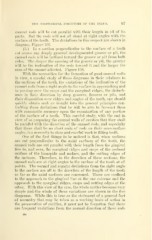Page 233 - My FlipBook
P. 233
THE HISTOLOGICAL STRUCTUBE OF THE TEETH. 97
enamel rods will bo cut parallel with tlieir length in all of its
parts. But the rods will not all stand at right angles with the
surface of the tooth. The deviations in this respect are shown in
diagram, Figure 107.
(5.) In a section perpendicular to the surface of a tooth
cut across any deeply grooved developmental groove or pit, the
enamel rods will be inclined toward the groove or pit from both
sides. The deeper the opening of the groove or pit, the greater
will be the inclination of the rods toward it and the larger the
area of the enamel affected. Figure 108.
With the necessities for the formation of good enamel walls
in view, a careful study of these diagrams in their relations to
the surfaces of the teeth, the variations of the inclination of the
enamel rods from a right angle to the surface in approaching and
in passing over the cusps and the marginal ridges, the disturb-
ance in their dii'ection by deep grooves, fissures or pits, and
their disposition over ridges and angles of the teeth, one should
quickly obtain such an insight into the general principles con-
trolling these deviations that he will be able to forecast them
with reasonable accuracy upon the examination of any portion
of the surface of a tooth. This careful study, with the end in
view of so preparing the enamel walls of cavities that they shall
be parallel with the direction of the enamel rods, and especially
that there shall be no short ends of rods on their cavo-surface
angles, is a necessity to close and careful work in filling teeth.
One of the first things to be noticed is that, when sections
are cut perpendicular to the axial surfaces of the teeth, the
enamel rods are cut parallel with their length from the gingival
line to, and over, the marginal ridges and cusps of the occlusal
surface of the bicuspids and molars, and the cutting edges of
the incisors. Therefore, in the direction of these sections, the
enamel rods are at right angles to the surface of the tooth at all
points. The normal and regular deviations from the right angle
to the surface are all in the direction of the length of the tooth
so far as the axial surfaces are concerned. These are confined
to the approach to the gingival line at the one extreme and the
approach to the marginal ridges, cusps and cutting edges at the
other. With this view of the case, the whole matter becomes very
simple and the whole of these variations are shown in the five
diagrams. While this is true as the statement of a general fact
of normalcy that may be taken as a woi'king basis of action in
the preparation of cavities, it must not be forgotten that there
are frequent variations from the normal direction of these rods
15a


